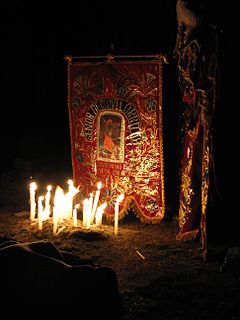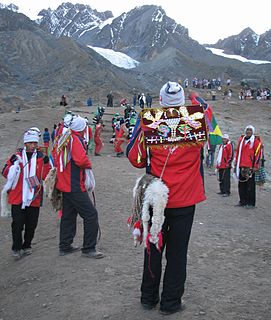
María Cleofé Sumire de Conde is a Peruvian politician. She belongs to the Union for Peru party and was a Congresswoman representing Cusco for the period 2006-2011.

Chumbivilcas(3D-map) is a province in the Andes in South Peru. The Inca called it "Chumpiwillka". The seat of the province is Santo Tomás. Officially Chumbivilcas was founded on June 21, 1825.

The Pomabamba Province is one of twenty provinces of the Ancash Region in Peru. It was formerly called Pumapampa and today it is also known as "The City of Cedars". It is located at the left bank of the Pomabamba river, at 3,063 meters (10,049 ft) above sea level. It was created by law on February 21, 1861.

Canas Province is one of thirteen provinces in the Cusco Region in the southern highlands of Peru.

Checca District is the largest of eight districts in the Canas Province in Peru. Its seat is Checca.

Quehue is one of eight districts in the Canas Province in Peru. Its seat is the village of Quehue.

Canchis Province is one of thirteen provinces in the Cusco Region in the southern highlands of Peru.

Quyllurit'i is a religious festival held annually at the Sinakara Valley in the southern highlands Cusco Region of Peru. Local indigenous people of the Andes know this festival as a native celebration of the stars. In particular they celebrate the reappearance of the Pleiades constellation, known in Quechua as Qullqa, or "storehouse," and associated with the upcoming harvest and New Year. The Pleiades disappears from view in April and reappears in June. The new year is marked by indigenous people of the Southern Hemisphere on the Winter Solstice in June, and it is also a Catholic festival. The people have celebrated this period of time for hundreds if not thousands of years. The pilgrimage and associated festival was inscribed in 2011 on the UNESCO Intangible Cultural Heritage Lists.
Huamantanga is one of seven districts of the Canta Province in Peru.
Livitaca District is one of eight districts of the Chumbivilcas Province in Peru.
San Jerónimo District is one of eight districts of the Cusco Province in Peru. It is home to the Universidad Andina del Cusco. According to the 2007 census, there are 31,687 residents in the district. A large part of the population communicates in Quechua.

Olleros District is one of twelve districts of the province Huaraz in Peru.

Jolljepunco, Colquepunco or Sasahui (sasawi) local name for Leucheria daucifolia, -ni an Aymara suffix to indicate ownership, "the one with the sasawi plant", hispanicized Sasahuini) is a mountain in the Andes of Peru and the name of a lake near the peak. The mountain is about 5,522 metres (18,117 ft) high. It is situated in the northern extensions of the Vilcanota mountain range in the Cusco Region, Quispicanchi Province, in the districts Ccarhuayo and Ocongate and in the Paucartambo Province, Kosñipata District. Jolljepunco lies northwest of the lake Singrenacocha, southeast of Minasnioc. The lake named Jolljepunco is situated south of the mountain at 13°32′04″S71°12′29″W.

Hatun Ch'aqu is a mountain in the Andes of Peru, about 5,000 metres (16,404 ft) high. It is located in the Cusco Region, Canchis Province, Pitumarca District, and in the Quispicanchi Province, Cusipata District. It lies south-west of the mountain Ch'aqu, west of the mountain Yanaqaqa, north-west of the mountain Tiklla Q'asa and north of the mountain Tuqtu. Its ridge stretches to the north-west.

Tuqtu is a mountain in the Andes of Peru, about 5,000 metres (16,404 ft) high. It is situated in the Cusco Region, Canchis Province, Pitumarca District, and in the Quispicanchi Province, Cusipata District. Tuqtu lies northwest of Tiklla Q'asa, near Hatun Ch'aqu, south of it.
Lake Tuctococha is a lake in Peru located in the Junín Region, Yauli Province, Carhuacayan District. It lies northeast of Yanque.

Tuqtu Q'asa is a mountain in the Bolivian Andes which reaches a height of approximately 3,120 m (10,240 ft). It is located in the Chuquisaca Department, Oropeza Province, Poroma Municipality. Tuqtu Q'asa lies southeast of Markawi.












